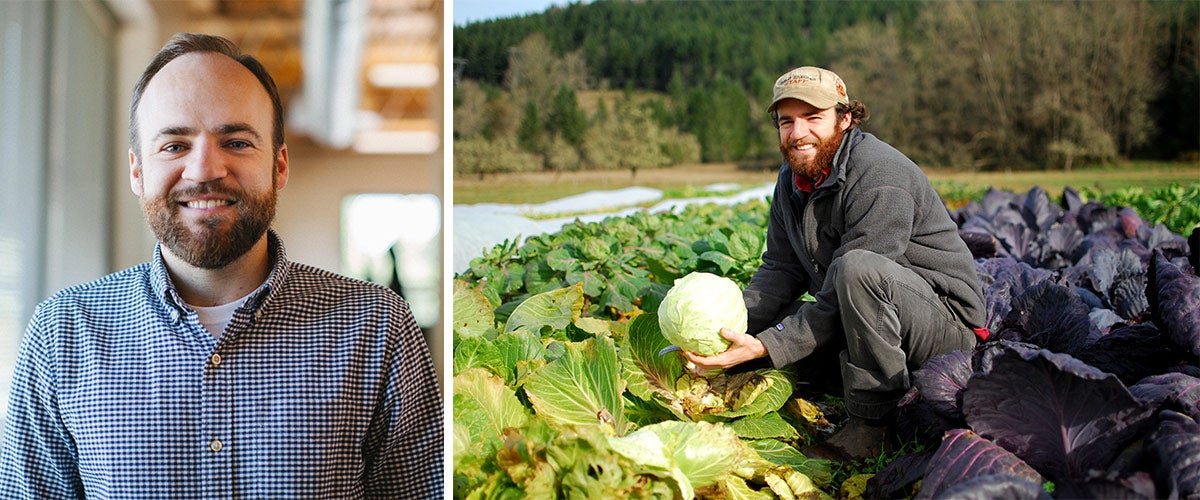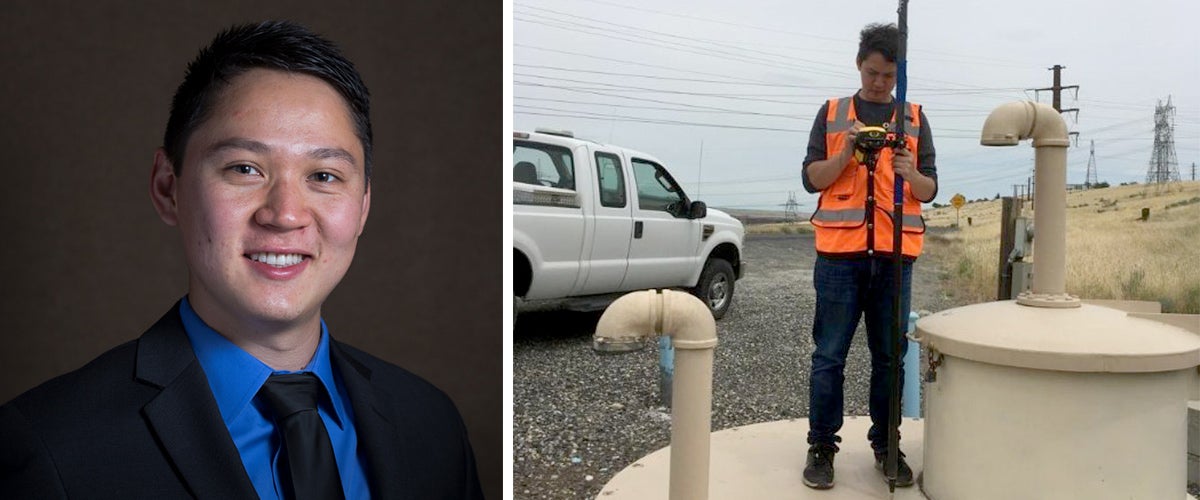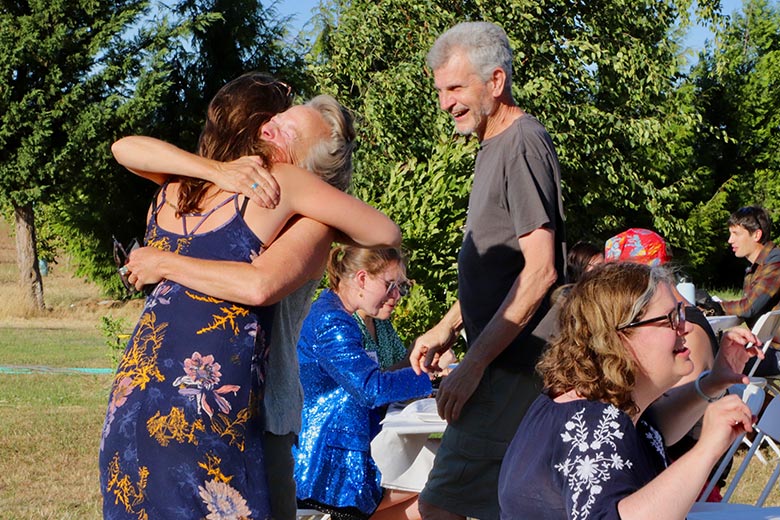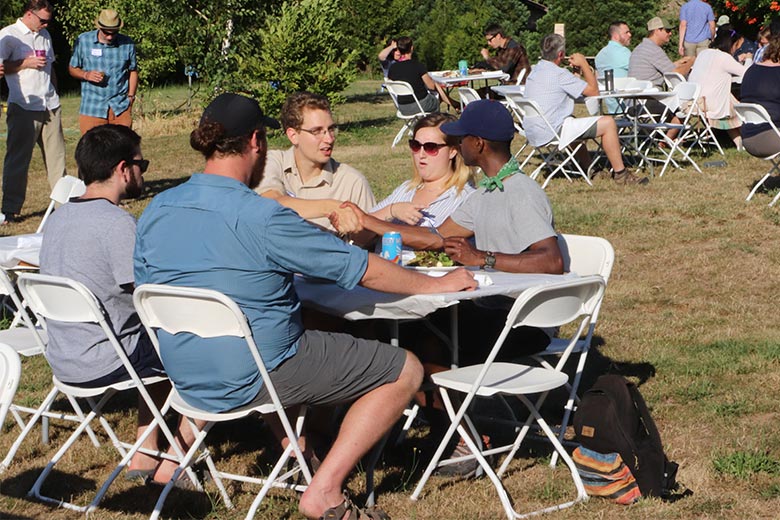As the sun set in the hills of Creswell, it cast long shadows silhouetting buzzing beehive boxes, apple and hazelnut trees, a herd of bison, and a small but mighty community dedicated to helping rural Oregon communities thrive.
At My Brothers’ Farm, a family-run operation, this community was hosting a reunion to celebrate the 25th anniversary of the Oregon-based AmeriCorps program known as RARE, or Resource Assistance for Rural Environments. Taylor Larson, one of the owners of My Brothers’ Farm, is a RARE alum who served in year 2012-13 in Tillamook. RARE operates within the Institute for Policy Research and Engagement (IPRE) in the School of Planning, Public Policy and Management (PPPM).
“You all are the reason we can stand here today and say, ‘We have made a difference in rural Oregon’,” Titus Tomlinson, the new RARE Program Director and alum (2006–07 and 2009–10), told a group of about 150, including fellow RARE alumni, their friends and family, and past community partners seated at tables in the grass.
 New RARE Program Director Titus Tomlinson and RARE Project Coordinator Aniko Drlik-Muehlck (left); Kevin Smith and Karen Laing, siblings of longtime Program Director Megan Smith
New RARE Program Director Titus Tomlinson and RARE Project Coordinator Aniko Drlik-Muehlck (left); Kevin Smith and Karen Laing, siblings of longtime Program Director Megan Smith
Karen Hyatt, the UO Director of Intergovernmental Affairs, took the mic and shared U.S. Representative Peter DeFazio’s statement that he read into the congressional record on July 22 acknowledging RARE’s contribution to the state. DeFazio, Oregon’s longest-serving congressperson, voted for the National and Community Service Trust Act of 1993, which first established AmeriCorps, paving the way for the inception of the RARE program.
“In the past 25 years, RARE members have completed more than 2,000 assessments, plans, and reports for local communities; written more than 700 grants, raised more than $6 million for communities, and recruited more than 10,000 community volunteers who served more than 8.6 million hours,” Hyatt read. “It is my pleasure to congratulate the RARE AmeriCorps program on 25 years of service to rural communities in Oregon and to thank RARE for its many vital contributions. I have no doubt these first 25 years of success will serve as the inspiration for the next 25.”
Pillars of the RARE program received heartfelt thanks, including the program founder David Povey (who was unable to attend), longtime IPRE co-director and PPPM Instructor Robert Parker, Departmental Grants Administrator Julie Foster, and Project Coordinator Aniko Drlik-Muehleck. Amid the speeches and catching up with friends, however, there was a notable absence: former RARE Program Director Megan Smith. Smith passed away in October 2018. She had been with RARE since the beginning.
 Memorial for Megan Smith at RARE reunion; RARE cohort from year two of the program, including Megan Smith, center, and David Povey, front right.
Memorial for Megan Smith at RARE reunion; RARE cohort from year two of the program, including Megan Smith, center, and David Povey, front right.
“We are all here today because of that amazing woman,” Tomlinson told the crowd.
Megan’s siblings, Annie Laing and Kevin Smith, also spoke at the event.
“The RARE program was so much of her soul,” Laing said. “You were her kids. She loved you all.”
Countless members of RARE, under the guidance of Smith, Povey, Parker, Foster, Tomlinson, and others, have gone on to help communities throughout Oregon. Here is a look back at how RARE shaped its participants, and how its participants have shaped Oregon and beyond.
Scroll to bottom for more photos from RARE reunion.
 RARE 25th Anniversary at My Brothers’ Farm
RARE 25th Anniversary at My Brothers’ Farm
 RARE Map of 25 years of service
RARE Map of 25 years of service
Keavy Cook, RARE 2002–03

Keavy Cook—now the director of The Ford Family Foundation’s Children, Youth, and Families department—joined RARE because she was looking to connect with communities in her own country before setting off on a career in international development. Before she was even selected for RARE, she drove from Boston cross-country to meet Megan Smith.
“I have strong memories of Megan Smith. She played more of a role in shaping my professional career and my life in Oregon than any other individual.”
Cook was accepted and served with the Siuslaw Watershed Council, where she launched a youth summer camp that still operates to this day and crafted a strategic plan and several grant applications. Cook received a Master in Community and Regional Planning in 2005. She never did go into international development, rather choosing to focus on development at home.
“Being in RARE helped me fall in love with Oregon, to feel closer to rural communities, and to develop confidence in my organizational development passions and understand how to apply this to community building,” Cook said. Cook explained how her relationship to RARE is multifaceted: She has been a participant, staff member as RARE’s field coordinator, and, now, a funder. “Not only does the program support the individuals who participate, but it also benefits the nonprofits and communities that host,” she said. “Human capacity is probably the number one thing needed in rural Oregon. RARE has that orientation, the reputation, and the structure to meet this need.”
Spencer Masterson, RARE 2010–12

Before joining RARE, Masterson spent a semester abroad in Thailand learning how development projects were adversely affecting the most vulnerable residents in predominantly rural areas. There he co-authored a human rights report that was presented to Thailand’s National Human Rights Commission, an experience that primed him for RARE.
For two years, Masterson served with the Ten Rivers Food Web, a food systems network in Linn, Benton, and Lincoln counties that works to increase the resilience of the area’s foodshed in the face of climate and economic uncertainty. As a result of community organizing and network development, he wrote a community food assessment of Linn County.
One of his proudest accomplishments during his time with RARE was launching a program that matches Oregon Trail Card benefits at farmers markets, which both provides low-income residents with access to locally grown foods and increases sales for local farmers. He also helped organize the Santiam Food Alliance, a community organization that focuses on spreading the joy of growing, buying, cooking, and eating local foods throughout the Santiam River basin.
Masterson, who is now associate director of Partnerships & Programs at Oregon Food Bank, said he uses the skills he picked up in RARE on a daily basis. “I learned so much about how communities can band together to make the change they wish to see in their communities,” Masterson said. “I also was able to hone many practical skills such as meeting facilitation, public speaking, and grant and budget management.”
Michael Held, RARE 2011–12

While pursuing a master of public administration degree (’11) at PPPM and working as an economic development planning intern with the City of Oakridge, Held met several RARE alumni and Megan Smith, who encouraged him to apply for the program. “Megan became an immediate mentor and someone who I was naturally drawn to because of her tenacity for public service,” Held said.
Through RARE, Held served with the Port of The Dalles, working on two major projects and several smaller initiatives. The first project Held spearheaded was the planning and implementation of a $5.5 million industrial lands redevelopment of a 77-acre mill site, which paved the way for dozens of new jobs and private investment.
He also facilitated a wetland planning process, which established a regional general permit, or a regulatory device that expedites business permitting and development while transparently maximizing environmental protections.
“The relationships I’ve established through RARE serve as my career’s backbone,” Held said. That career has led him to his current position as director of Rural Economic and Policy Services at Rural Development Initiatives based in Eugene.
“To this day, the program embodies that public service spirit and is to be commended for its intentional cultivation of public-minded leaders,” Held said. “I view RARE as a critical component to creating an equitable and just social and economic environment for rural communities.”
Held says he has hired RARE alumni; he’s also engaged to a RARE alumna he met at an earlier RARE reunion.
Jasmine Jordan, RARE 2016–17

Before moving to Oregon to from the Midwest to join the RARE program, Jasmine Jordan went to Burkina Faso with the Peace Corps to be an economic development volunteer with projects focused on small businesses, irrigation, and reforestation.
“I always wanted to round out my foreign service by giving back to a community stateside,” said Jordan, who had graduated from the University of Dayton, Ohio, with a BA in political science and international studies.
In 2016, Jordan began the RARE program, working as a main street program coordinator for St. Helens Economic Development Corporation (SHEDCO) in northeast Oregon. In St. Helens, she facilitated the development and promotion of local businesses and proprietors through collaboration with the city planning department. Jordan helped write grants for restaurant expansions and art installations, recruit volunteers, develop the SHEDCO website, create wayfinding, and put on events such as the Spirit of Halloweentown celebration (the Disney Channel movie Halloweentown was filmed here).
Her biggest impact, she said, was the grant she wrote for the rehabilitation of El Tapatio restaurant: In 2017, the restaurant received $100,000 from the Oregon Parks and Recreation Department’s Main Street Revitalization Grant.
“My position in St. Helens exposed me to many professionals that work in planning, public policy, city government, and economics, specifically the finance and economic firms the city hired to work on urban renewal,” Jordan explained. Exposure to that work and having conversations with these professionals over lunch, she said, helped her decide between going to graduate school for economics or public policy. Jordan is currently a second-year PhD student in economics at the University of California, Riverside.
“RARE’s ability to place, train, and encourage volunteers has truly proven itself over its 25 years of commitment to the State of Oregon,” she said.
Matt Tsui, RARE 2016–18

The Penn State University environmental science and geographic information systems (GIS) graduate Matt Tsui applied to RARE because it met three criteria to jumpstart his career:
- an entry-level job in an interesting field for someone who only had internship experience
- the opportunity to immerse in the culture of a new state
- the chance to alleviate some student loan debt through the Segal AmeriCorps Education Award.
Tsui said he walked away with so much more than that.
“It provided me with a family,” Tsui said. “I have had a lot of pretty amazing jobs in the past, but my experience with RARE far beats the rest, because of the support and joy that I received from my RARE fam.”
Tsui served as a geographic information system (GIS) coordinator for the City of Umatilla, specifically the public works department, where he collected locations and attributes for all 2,154 city-owned water and sewer utilities. For the data collected, Tsui developed mobile web mapping applications to streamline access to utility maps and plans in the field. In short, Tsui helped modernize the system, establishing a GIS-based tool that helps the planning and public works department make better daily and long-term decisions about how to improve utility services for Umatilla residents.
“RARE provided me with the time and flexibility to make mistakes and learn the core principles of geographic information systems.”
Tsui uses the principles and skills he learned in his current position in North Carolina as an ArcGIS analyst for Esri, a GIS company that builds mapping and spatial analytics software. RARE is so important to Tsui, he noted, that he flew across the country for the reunion and back in just 48 hours.
Emma Porricolo, RARE 2016–18

RARE provided Emma Porricolo with the experience and qualifications that helped her acquire her current job as assistant planner with the Portland-based Angelo Planning Group. In 2016 as Porricolo neared completion of her bachelor’s degree in Environmental Science (with minors in PPPM and geology), she says her PPPM advisor Jessica Matthiesen suggested she give RARE a try.
“My time with RARE provided ‘real world’ experience that has been invaluable and allowed me to truly understand how cities function and the role of city planners at the local, regional, and state level,” said Porricolo. “Through my time serving with RARE, I gained an understanding and appreciation for the cultural differences across the state of Oregon.” Porricolo began serving with RARE in 2016 as a main street program coordinator for the Hermiston Downtown District. Here, Porricolo developed a network of stakeholders to focus on downtown and helped the district gain 501(c)3 nonprofit status. She said the network continues to partner on events and promotions that bring people downtown.
In her second year, she served as a downtown planner for the City of Sandy, working on a walkability study and a master plan for downtown expansion.
“Learning firsthand that I could connect with people very different from myself and collaborate with them to reach a shared goal was a pivotal experience for me,” Porricolo said.
Corum Ketchum, RARE 2017–19

Corum Ketchum, who received his undergraduate degree in Planning, Public Policy and Management in 2016, first discovered RARE when he was taking the course Real World Eugene and working with the city to research student transportation projects. Megan Smith came and pitched the program to the class. “I didn’t know it at the time, but the conviction from that red-haired woman would point me toward the beginning of my career.”
Ketchum just completed his second year with RARE, where he has served as an economic development specialist with the City of Veneta. During his tenure, Ketchum worked on a wide variety of projects including developing a network of local and regional economic development professionals, planning large public events such as Veneta’s downtown festival, and writing policy reports to guide the decision-making of staff and elected officials. He also wrote grants for more than $300,000 in economic and infrastructure projects.
“RARE has been the perfect opportunity to apply what I learned in PPPM in a professional context,” Ketchum said. “RARE has made me feel both empowered and vulnerable. Clearly, I have been able to apply myself to a wide range of problems and make my mark. That has been gratifying, but it is the humility I have gathered from spending time with the people I’ve met along the way where I have grown the most as a person.”
Ketchum will return to the School of Planning, Public Policy and Management this fall to pursue a Master in Public Administration.
Originally published by UO School of Planning, Public Policy and Management
 New RARE Program Director Titus Tomlinson and RARE Project Coordinator Aniko Drlik-Muehlck (left); Kevin Smith and Karen Laing, siblings of longtime Program Director Megan Smith
New RARE Program Director Titus Tomlinson and RARE Project Coordinator Aniko Drlik-Muehlck (left); Kevin Smith and Karen Laing, siblings of longtime Program Director Megan Smith Memorial for Megan Smith at RARE reunion; RARE cohort from year two of the program, including Megan Smith, center, and David Povey, front right.
Memorial for Megan Smith at RARE reunion; RARE cohort from year two of the program, including Megan Smith, center, and David Povey, front right.




















 “Over 24 months, RARE and Spark Northwest will work together to evaluate renewable energy opportunities and provide renewable energy development assistance directly to rural small businesses, farms, agritourism operators, and agriculture producers across the state,” RARE outlined in its grant application. “The project will provide education to engage with at least 150 farmers and small businesses about energy opportunities, provide project-specific consultations for at least 40 of these entities, and shepherd at least 20 energy projects successfully through the development phase.”
“Over 24 months, RARE and Spark Northwest will work together to evaluate renewable energy opportunities and provide renewable energy development assistance directly to rural small businesses, farms, agritourism operators, and agriculture producers across the state,” RARE outlined in its grant application. “The project will provide education to engage with at least 150 farmers and small businesses about energy opportunities, provide project-specific consultations for at least 40 of these entities, and shepherd at least 20 energy projects successfully through the development phase.”